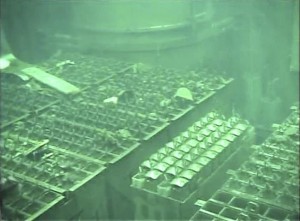 Fukushima Unit 4’s spent fuel pool teeters on the brink of collapse threatening a never-ending nuclear fire
Fukushima Unit 4’s spent fuel pool teeters on the brink of collapse threatening a never-ending nuclear fire
NEWS, ANALYSIS AND COMMENTARY
Japan courts a potential country-killing catastrophe as it literally puts the lid on any chance of saving a nuclear reactor’s spent fuel pool before further disaster strikes.
In the process, the situation has gravely worsened and is far more likely to precipitate the very calamity the Japanese government and Fukushima-Daiichi owners purport to be trying to stop – an uncontrollable and never-ending nuclear fire which could take over a hundred years to burn through over 3 million pounds of hot goo.
But not just any nuclear fire, an unquenchable fission-fed fire water can’t cure. It would release so much gamma radiation that Fukushima would have to be abandoned – those flimsy white suits seen in photos of Fukushima workers provide minimal protection only against alpha and beta radiation.
Abandoned, the entire site’s spent fuel pools would eventually dry up and ignite with an uncontrollable nuclear conflagration that would burn for hundreds of years. Just Unit 4’s spent fuel pool alone would release more than 85 times the amount of cesium-137 let loose by the 1986 Chernobyl meltdown.
The possibility of a total failure of Unit 4, which would take the pool with it, was hugely increased recently according to a June 15 press release by Fukushima-Daiichi owner Tokyo Electric Power Company (TEPCO). Photos in it show a so-called “Protection Platform Installation on Unit 4 Spent Fuel Pool” being lifted off the ground and lowered into place over the pool.
The photos also show that no new shoring to the destroyed reactor building had been built, indicating that the weakened structure now had to support 60 more tons. The heavy 36-foot by 45-foot lid also takes away the only way to extricate the spent fuel rods from the pool – from the top.
TEPCO claimed that the lid was “to prevent rubble from falling into the pool” yet photos released by the company show nothing above the pool now that could fall into it – it had already been carefully removed without any apparent chunks of Unit 4 blown apart superstructure falling into it.
Now, according to TEPCO, the spent fuel pool needed a 60-ton lid to keep out what wasn’t there in the first place because it had already been taken away without wrecking the rods.
Indeed, the reason TEPCO’s brave but most likely doomed workers could lower the plate down on top of the spent fuel pool in the first place was because nothing was over it.
If TEPCO felt issuing misleading information about the weighty lid was its only option, the actual reasons for covering the spent fuel pool could be that they already know that it is beyond salvage and better to have it covered than open for any satellite to peer into.
Like most of TEPCO’s inept and hazardous handling of this disaster, even a 60-ton slab of steel may not cover-up the truth of the spent fuel pond for very long; the April 26, 1986 Chernobyl meltdown blew a much heavier 1,000-ton concrete lid off of that reactor.
The Japanese government has signed off on Hell’s hot plate either oblivious to the potential consequences or inured to them. Motive can be gleaned, however, when looking at a pattern. Apathy or recklessness do not account for the nation-wide deliberate burning of millions of tons of irradiated rubble, which likely impacts millions of Japanese.
That inexplicable process, which has been demonstrated against in Japan by people angry at getting exposed to additional radiation, volatilizes and mobilizes Fukushima fallout trapped in all manner of material. These radioactive-infused gases travel into the atmosphere impacting Japan and beyond.
Even the incineration of millions of tons of Fukushima debris, debris that would be better left in place as the land is unusable for now anyway, does not present the apocalyptic scenario spelled out if Unit 4’s spent fuel pool fails.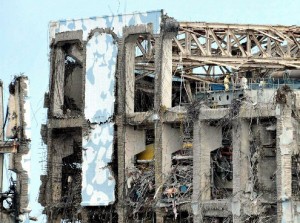
The American and Canadian governments’ response is no response at all. The occasional reply to concerned citizens (who have shared them with EnviroReporter.com) indicates an official response usually long on dismissive rhetoric and short on facts.
All the while the Pacific Ocean is being poisoned with 1,000 tons of highly irradiated water dumping into it from the melted down reactors in a desperate bid to keep them from erupting into their own uncontrollable infernos.
DANGEROUS GROUND
On June 17, an earthquake measuring 6.4 hit off the coast of the prefecture next to Fukushima. All the while a storm with 93 mph winds bore down on the coastal nuclear complex.
Numerous earthquakes have rattled Fukushima since “3/11” including a magnitude 6.8 quake in Fukushima last August. There were reports of cracks in the ground with steam venting from the fractured earth leading to speculation that the nuclear fuel from the reactors was in the groundwater, one of the worst “melt-out” scenarios.
Fear that Unit 4’s heavy spent fuel pool might collapse causing untold misery is based on the inventory of what’s in that pool, which TEPCO has braced from beneath where it spotted a leak in the containment vessel.
There is a reason for this – Unit 4’s spent fuel pond contains enough uranium and plutonium-based fuel rods, which are far more radioactive than fuel assemblies in use in reactor cores, to destroy most if not all of Japan if the rickety pool should collapse to the ground or leak from losing its cooling water.
Such a scenario could cause the 460 tons of irradiated fuel to explode in fire and fission, an inferno that cannot be extinguished by all the water in the world, an inferno that would lead to the mandatory evacuation of the Fukushima-Daiichi site which would then leave an even larger common spent fuel pool untended which would in turn erupt into an inferno of goo that could change civilization as we know it.
The destroyed Fukushima-Daiichi nuclear reactor Unit 4 didn’t fully melt down like Units 1, 2 and 3 did during the March 11, 2011 Tōhoku earthquake and tsunami. Unit 4 exploded four days later leaving its nuclear reactor spent fuel pool hanging suspended 100 feet in air. Then the building started to lean under the weight of the pool, weakened by its blown out walls.
Instead of rushing to brace this structure, however, the Japanese government has slowly removed the superstructure above and around three quarters of the spent fuel pond. Other than cosmetic changes to the site, such as flimsy coverings for the melted reactors, Japanese officials have proven inept at controlling the calamity and have excelled only at misleading the Japanese people and the rest of the world about how precarious and out of control the debacle is.
The government and TEPCO have not only failed to control this worsening disaster, which both claimed was in “cold shutdown” last December, they have embarked on a series of actions that threaten to bring down the pool even faster than if nothing were done at all.
For over a year, citizens and anti-nuclear activists have repeatedly called for this incredibly unstable structure to be stabilized lest the pool crash to the ground in another earthquake, tsunami or typhoon.
Dale Ramicone, a Glendale resident who operates an online streaming Radiation Station, has advocated reinforcement of Unit 4 with a steel super structure or even hundreds of thousands of sandbags — a convenient option since the super-irradiated site sits on a beach — to brace up the wrecked structure against falling over in an inevitable earthquake.
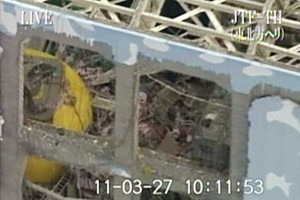 “I think it is hanging by a thread,” Ramicone says. “Adding more weight to it without strengthening the building’s support structure seems to be a big gamble. Any additional earthquake shocks or even a typhoon might be the the final blow that unleashes a radioactive firestorm.”
“I think it is hanging by a thread,” Ramicone says. “Adding more weight to it without strengthening the building’s support structure seems to be a big gamble. Any additional earthquake shocks or even a typhoon might be the the final blow that unleashes a radioactive firestorm.”
The steel lid does none of this and weakens the structure especially in a significant earthquake as it sways back and forth high in the building right over the spent fuel pond, protecting it from nothing except rain when those hot rods need all the water they can get. All the while, the unreinforced and cracked skeleton of the building now has this immense weight it wasn’t designed to support even if it weren’t blown to smithereens.
Japan’s handling of this disaster and its willful and wanton disregard for the well-being of its citizens may destroy the country. Much of it relies on the vagaries of which fault cuts loose with the shaker that brings down the burning pool and which way the wind blows when the fountain of fissioning goo catches fire never to go out.
Downwind and down current of this fiasco, American and Canadian officials either don’t know better, or do and for some inexcusable reason, choose to do nothing about it. Considering the stakes on the line, that could be called treason.
A crime against humanity is unfolding in Japan due to the negligent and ill-conceived actions of a government that kowtows to Japan’s nuclear industry. The Japanese people are the first to suffer. They won’t be the last.
3/11 – THE NUCLEAR 9/11
The Great East Japan Earthquake, as it is also called, was the largest earthquake to ever hit Japan in known history. It lasted around six minutes.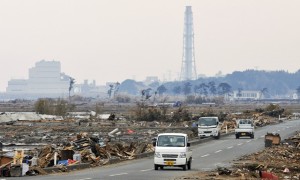
The seismic shaking and subsequent tsunami waves, up to 133 feet high, killed 15,861 with 6,107 missing according to the National Police Agency of Japan. It also set off a series of events that has impacted the world and all of humanity for thousands of years to come.
Three of the six nuclear reactors at the Fukushima Daiichi nuclear power plant melted down and three hydrogen explosions occurred. These events released enormous amounts of radioactivity into the atmosphere, onto the land and into the Pacific Ocean.
The radioactive fallout not only contaminated Japan but also went into the jet stream over to North America.
The Pacific Northwest National Laboratory reported that Richland Washington had radioactive Xenon-133 levels 450,000 times above detection levels after Fukushima that persisted for weeks.
California and Oregon were also hard hit. Milk in San Francisco was found to have Cesium 137 at 160% above the Maximum Contamination Levels set by the Environmental Protection Agency. The atmospheric currents carried radioactive Plutonium to Lithuania. The fallout went around the Northern Hemisphere.
It also went into the Pacific Ocean and followed the Kuroshio Current that makes its way to the West Coast of North America and then splits into two – one flowing south down the California coast and the other moving north up to Alaska.
By the end of May 2012, it was reported by the Academy of Sciences that every one of the 15 tuna sampled in the previous August in the California waters were contaminated by radioactive Cesium 137 from Fukushima.
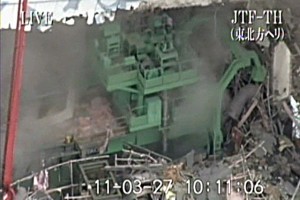 Many experts have talked about how huge a disaster this is – it was definitely rated at a 7 – the highest level of nuclear accident possible. Some have said it’s at least as big as the 1986 Chernobyl nuclear accident that was also rated a 7. Others have placed it at 3 to 10 times bigger. Even TEPCO, the company that runs the Fukushima Daiichi plant, estimates that the total radioactive releases were in the order of a million trillion Becquerels – that’s a lot of radioactivity when you consider that every single Becquerel represents one radioactive “explosion” of an atom every second.
Many experts have talked about how huge a disaster this is – it was definitely rated at a 7 – the highest level of nuclear accident possible. Some have said it’s at least as big as the 1986 Chernobyl nuclear accident that was also rated a 7. Others have placed it at 3 to 10 times bigger. Even TEPCO, the company that runs the Fukushima Daiichi plant, estimates that the total radioactive releases were in the order of a million trillion Becquerels – that’s a lot of radioactivity when you consider that every single Becquerel represents one radioactive “explosion” of an atom every second.
This is the single greatest nuclear contamination of the oceans ever seen in history. The labels really don’t matter – it is enough to say that it is an enormous catastrophe. Chernobyl, as big as it was, was shut down in 18 days. Although the Japanese announced “cold shutdown” in December of 2011– it is now clear that that was a myth and that the reactors are still giving off trillions of Becquerel’s of radioactivity every day.
To make matters worse, the Japanese are transporting an estimated 20 million tons of radioactive debris all over Japan and having it incinerated in an attempt to reduce its volume. This incineration doesn’t reduce the radioactivity, it simply disperses it into the atmosphere all over Japan and over to North American in the jet stream.
Even though this news story is bigger than any you will read in the daily newspapers, the mainstream media rarely report on this continuing and ongoing disaster. The U.S. and Canadian governments are not monitoring their countries’ air, soil, food or Japanese imports for radioactivity. The official “line” is that “there is no cause for concern” and yet how can they know that that’s the case if they are not testing on a regular basis? .
WHERE THERE’S SMOKE THERE’S FISSION
Four of the six reactors at the plant have continuing problems but the reactor that puts the world most at risk is Unit 4.
Although the reactor at Unit 4 was not operating at the time of the disaster, the building was extremely damaged structurally by a hydrogen explosion on March 15, 2011. The roof blew off the building exposing the 1535 so-called “spent” fuel assemblies containing 460 tons of nuclear fuel that are housed precariously 100 feet above the ground in a fuel “pool.”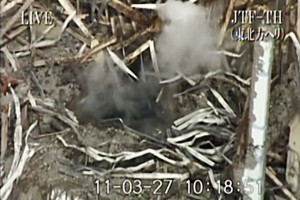
It is important to point out that the word “spent” belies the truth about these fuel assemblies. They contain the rods that have been previously used in the reactor but are many times more radioactive than when they first went into the reactor.
Not only was the building at Unit 4 severely damaged during the explosion but its cooling system – essential for keeping the rods cool – was damaged as well. TEPCO did do some structural work on the foundation of building 4 and “jury rigged” a temporary cooling system using fire hoses. They claim the building is safe. But the situation is nowhere near safe.
Even though TEPCO says it has reinforced the foundation of Unit 4, it admits the wall is bulging. The building is leaning precariously and its seismic capability has been rated at zero. It would take very little to cause this building to collapse.
Experts have stated that an earthquake of 7, an explosion or even a storm could cause the building to crumble and the cooling system to be lost.
This would set off a fire in the spent fuel pool that contains the 460 tons of fuel. The radioactivity released would be so high that workers would not be able to get close to the other reactor units at the site and so the ongoing work of keeping those units cooled would end. The water in all the units would evaporate and the hot fuel rods in these units would also ignite. The 6291 fuel rods in the common pool on the ground would also be set on fire.
The type of fires that would be created could not be put out by water. The fires would just have to burn until all the stored nuclear fuel was burned up.
In all, the Fukushima Daiichi site holds 10,893 fuel assemblies. Those fuel assemblies hold a total of 3,488,000 lbs. of radioactive nuclear fuel including highly toxic Uranium, Plutonium and Cesium 137.
The fires would cause an unprecedented amount of radiation to be released directly into the atmosphere.
The nuclear fallout released would be at a level higher than the amount of radioactive Cesium 137 that was released in all the 700 atomic bomb tests ever conducted in the world in the above ground testing that was carried out in the 1940’s, 50,’s 60’s and 70’s.
It would release 85 times more Cesium 137 than was released at Chernobyl in 1986. Chernobyl is still uninhabitable 36 years later. Recent studies of Cesium 137 at Chernobyl, which has a half-life of about 30 years, didn’t show any decrease in the radioactivity of the isotope, puzzling scientists and possibly foretelling an even more extended period before Fukushima will be anywhere near inhabitable.
It would contaminate Japan, cause the evacuation of Tokyo, plus go directly into the jet stream and over to Canada, the United States and all around the Northern Hemisphere.
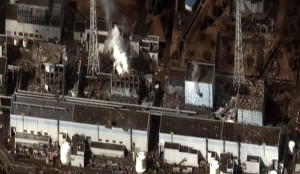 This catastrophic amount of radiation would affect people’s health for generations. It would cause irreversible contamination of crops, water and land. It would contaminate the Pacific Ocean – to a much greater extent than has been happening over the last year and a half. It would cause great harm to all marine life.
This catastrophic amount of radiation would affect people’s health for generations. It would cause irreversible contamination of crops, water and land. It would contaminate the Pacific Ocean – to a much greater extent than has been happening over the last year and a half. It would cause great harm to all marine life.
And it would do great harm to all the people of this planet. The U.S. National Academy of Sciences has determined that there is no safe level of radiation. Zero. Every exposure to radiation increases the risk of cancer, spontaneous miscarriage, stillbirths, childhood mortality, birth defects and many other diseases.
One need only to look at Chernobyl 26 years later to see what awaits. After Chernobyl, in all the areas affected, hundreds of scientific studies have proven that there was a significant increase in heart attacks and cardiovascular diseases, thyroid cancer, lung cancer, breast cancer, diseases of the central nervous system, increase in stillbirth rates, increase in miscarriages, increase in infant deaths and a decrease in birth rates. Consider an 85-times-worse scenario. No wonder many experts are saying that this is an issue of human survival.
When a body ingests or inhales a radioactive particle, that particle releases damaging radiation inside the body over a long period of time. New findings indicate that ongoing low levels of radiation may be more harmful than one large insult.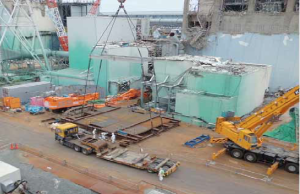
There are over 200 radioisotopes coming our way from Fukushima. A brief review of what just three of them can do shows that Strontium 90 lodges in the bone and causes bone cancer and leukemia. Cesium 137 goes to the brain, muscles and heart and wreaks havoc there. Iodine 131 accumulates in the thyroid gland and causes thyroid cancer.
These effects don’t happen overnight and so the nuclear industry believes it is safe – no cancer or illness will ever have “Fukushima” stamped across the forehead of the victim.
Fetuses are the most at risk to damage from radiation. Infant girls are the next most susceptible –7 times more so than a 30 year old male. Girls are twice as sensitive as boys of the same age. Fukushima is an untold tragedy for our young and most vulnerable.
Nuclear expert Arnold Gunderson of Fairewinds and Associates fears that the entire Northern Hemisphere could be uninhabitable if Unit 4 collapses. He has suggested that it may be so serious that citizens on the West Coast of North America would have to evacuate to South America.
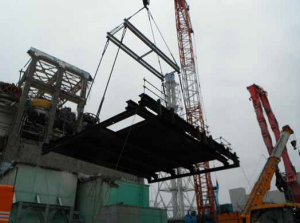 Adding to the precariousness of this nightmare is that the Fukushima Daiichi site sits on a highly active earthquake zone. The area is subject to hundreds of earthquakes – more than usual since the 9.0 earthquake last year. These frequent earthquakes have registered between 3 and 6.4. Each one continues to weaken the building at Unit 4.
Adding to the precariousness of this nightmare is that the Fukushima Daiichi site sits on a highly active earthquake zone. The area is subject to hundreds of earthquakes – more than usual since the 9.0 earthquake last year. These frequent earthquakes have registered between 3 and 6.4. Each one continues to weaken the building at Unit 4.
Modern Survival blog mapped all the earthquakes over 5.0 near Fukushima since the beginning of 2011 and the resultant map is covered in circles denoting these earthquakes. It would be an understatement to say that this area is not stable.
A February 2012 study by the European Geosciences Union shows that the seismic risk at the Fukushima plant has increased. The March 2011 earthquake of 9.0 jolted the plates underneath the area into a more precarious position and reactivated the seismic fault. The scientists cannot predict exactly when the next large earthquake will occur but they did say it will happen in the “near future.”
The situation is grave. But is it clearly the greatest threat to humanity?
Robert Alvarez thinks so. He is former Senior Policy Adviser to the Secretary and Deputy Assistant Secretary for National Security and the Environment at the U.S. Department of Energy, and has been quoted as saying: “It is important for the public to understand that reactors that have been operating for decades, such as those at the Fukushima-Daiichi site have generated some of the largest concentrations of radioactivity on the planet. It might be difficult to appreciate the actual meaning of the situation, yet we can grasp what 85 times more Cesium-137 than Chernobyl would mean. It would destroy the world environment and our civilization. This is not rocket science, nor does it connect to the pugilistic debate over nuclear power plants. This is an issue of human survival.”
TAKING CARE OF HUBRIS
TEPCO is a business corporation. It is neither motivated nor able to solve this difficult technical problem with urgency. Shocking news came out this year that within hours of the initial earthquake 1½ years ago, TEPCO was planning to evacuate all its workers from the plant and just walk away from the disaster. The then Prime Minister Kan had to order them to stay and work to contain the disaster. If TEPCO had left the scene, the scenario outlined above would have occurred last year.
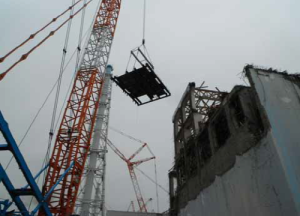 This entire disaster is being handled by a company that is no longer making money at Fukushima. TEPCO’s mandate is not to save the world. Indeed, in 2011 it absconded itself for all radiation leaving its property which could potentially mean that someone breathing in Plutonium 239 from Fukushima, gets lung cancer and dies, it will not be the company’s fault because, technically, the cancer victim owned the deadly radionuclide for which the company takes no responsibility.
This entire disaster is being handled by a company that is no longer making money at Fukushima. TEPCO’s mandate is not to save the world. Indeed, in 2011 it absconded itself for all radiation leaving its property which could potentially mean that someone breathing in Plutonium 239 from Fukushima, gets lung cancer and dies, it will not be the company’s fault because, technically, the cancer victim owned the deadly radionuclide for which the company takes no responsibility.
Recently Sumio Mabuchi, former minister of Land, Infrastructure, Transport and Tourism stated he had suggested building a sarcophagus over reactor 4 as they had done in Chernobyl. However TEPCO rejected it “for financial reasons.”
TEPCO does have a plan to clear all the debris around the reactor building 4 and build a structure that can hold a crane that will remove the fuel rods to a safer place.
One weakness of the plan is that they only plan to remove the rods to the common pool on the ground. This common pool already holds over 6000 spent fuel rods. This pool is still vulnerable to another earthquake, could still drain, catch fire and cause the chain of events discussed earlier.
In the March 2011 earthquake, the only fuel that was left unscathed was the fuel that had been moved to the 9 dry cask storage containers. Dry casks may be the only solution but TEPCO is not planning to put the fuel rods into dry casks. Too expensive.
Another big problem is that TEPCO is working very slowly. They take weekends off and recently took an entire week off for “Golden Week.” They say they will have the debris removed by the end of 2013. And then they can start building the structure and start the removal of the fuel rods. Estimates are that this process will be completed in five or ten years.
The Japanese government is not helping to accelerate the process, either. Prime Minister Noda has the power to order TEPCO to bring in more workers and accelerate the process of removing the fuel rods from the roof of Reactor 4.
But the Japanese government is putting its energies into trying to convince the Japanese people that the radiation that has covered their country is harmless. The Japanese government is working hard to start up two reactors in Ohi Prefecture. This is the insanity of the situation – they haven’t come near to controlling the nuclear disaster that is threatening the very life of this planet and yet they are intent on restarting aging reactors that sit on an earthquake fault and have the same design flaws as at the Fukushima reactors.
The ultimate irony is that Prime Minister Noda says he must restart the nuclear reactors for the “survival of society.” He, of course, is talking about the need he sees to restart the Japanese economy. However, these reactors are on an active earthquake fault and if an earthquake hits the Ohi reactors, there will be no “survival of society.”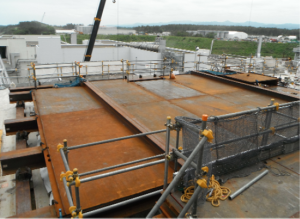
What has happened and is happening at Fukushima Daiichi is an extreme and continuing nuclear disaster that is being covered up by the governments and mainstream media. This catastrophe requires an army of people working furiously 24 hours a day to get the fuel rods removed before the big earthquake comes and the worst case scenario happens. All attention needs to be put toward averting an even bigger disaster than is already happening.
TIME OUT
Japan’s former Ambassador to Switzerland, Mr. Mitsuhei Murata said, “TEPCO is, after all, a for-profit company. It cannot be said to be making every possible effort. There is no time to waste. Knowledge from around the world should be gathered as soon as possible to begin the work of removing the nuclear fuel from the storage pool.”
At the Nuclear Security Summit Conference in Seoul on March 26 and 27, 2012, Ambassador Murata informed the participants from 54 nations of the potential global catastrophe of reactor Unit 4.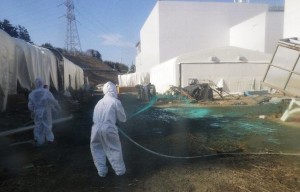
Murata wrote to UN Secretary General Ban Ki-moon, “It is no exaggeration to say that the fate of Japan and the whole world depends on No. 4 reactor.”
Senator Ron Wyden from Oregon, a senior member of the U.S. Senate Committee on Energy and Natural Resources who is highly experienced with nuclear waste storage issues, visited Fukushima in April 2012. When he returned he stated that the situation is “worse than reported,” with “spent fuel rods currently being stored in unsound structures.”
Senator Wyden warned that the Fukushima spent fuel was a U.S. national security issue because radiation caused by the pool failure “could reach the West Coast within days.”
Wyden sent letters to Secretary of State Hillary Clinton, Secretary of Energy Steven Chu, NRC Chairman Gregory Jaczko and Japanese Ambassador to the U.S. Ichiro Fujisaki. He appealed to everyone to work together and with the international community to address this situation as swiftly as possible.
Wyden reaffirmed that “The precarious status of the Fukushima Daiichi nuclear units…… should be of concern to all and a focus of greater international support and assistance.”
On April 30, 2012 seventy-two Japanese NGO organizations lead by Shut Tomari and Green Action Japan send an urgent request to UN Secretary General Ban Ki-moon and the Japanese Prime Minister Yoshihiko Noda urging immediate action to stabilize the Fukushima Daiichi Unit 4 spent nuclear fuel. The letter was endorsed by experts from Japan and abroad.
The letter urged the United Nations to organize a Nuclear Safety Summit to take up the crucial problem of the Fukushima Daiichi Unit 4 spent nuclear fuel pool. The letter stated that the United Nations should establish an independent assessment team on Fukushima Daiichi Unit 4 and coordinate international assistance in order to stabilize the unit’s spent nuclear fuel and prevent radiological consequences with potentially catastrophic results.
 Kaori Izumi of Shut Tomari stated, “Fukushima Daiichi is no longer a Japanese issue but is an international issue. It is imperative for the Japanese government and the international community to work together on this crisis before it becomes too late.”
Kaori Izumi of Shut Tomari stated, “Fukushima Daiichi is no longer a Japanese issue but is an international issue. It is imperative for the Japanese government and the international community to work together on this crisis before it becomes too late.”
On May 10, 2012 The Nuclear Information Resource Service started a petition to U.S. President Obama urging him to “Act now to prevent a second Fukushima disaster”
The petition points out that the situation at the Fukushima Daiichi nuclear site remains perilous and that the area has been hit with hundreds of earthquakes since March 11, 2011.
NIRS is urging President Obama to support UN intervention but also not to wait for the UN to act but to “forcefully begin providing substantive assistance, technical capability, skilled personnel and financial resources now.”
It further points out that “the U.S. has the capability to respond to this crisis immediately, to shore up the pool and to begin moving this fuel from the pool in 2012.”
Avaaz.org is calling for a “global wave of public pressure to the UN to force the (Japanese) government to work with the experts to curb this lethal threat that would dwarf last year’s disaster.” This petition is addressed to UN Secretary General Ban Ki-moon and Japan’s Prime Minister Noda with a plea to “Stop the Next Nuclear Disaster.” Avaaz says it’s time for urgent international action and is calling on global citizens to urge Ki-moon to send an independent team of international experts to assess the dangerous situation at Unit 4.
The Pacific Nuclear Awareness Group in Vancouver British Columbia sent a petition to the Canadian government that was read out to the Members of Parliament today. This petition asks the government to urge Ban Ki-moon and Noda to organize the Nuclear Safety Summit to take up the crucial problem of Unit 4 and to establish an Independent Assessment Team on Unit 4.
As well, the petition asks the Canadian government to participate in both the Summit and the Assessment Team. This group has also created a petition for Canadian citizens to sign.
They are encouraging everyone to sign all the petitions and “not participate in our own destruction because we are too busy with other things to take action.”
But the question remains; do petitions work? Jeff Jones, a Canadian lawyer, points out that petitions do have value because they are a means to educate people and a way to warn those in power.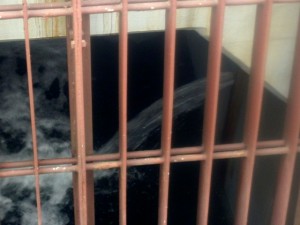
Nevertheless, with all the petitions and letter writing going on, the risk at Reactor 4 still remains. The building is still crumbling. Four hundred and sixty tons of fuel rods remain on the roof exposed to the atmosphere. A 7.0 earthquake can still hit any day.
So far the United Nations has not responded to the petitions sent to them. President Obama has not taken action based on the petition he received. Prime Minister Noda has clearly ignored the petitions sent his way. And to add an additional problem to the mix, even if the United Nations, Canada and the United States decide to act and work together to help Japan, it is not clear that the Japanese will accept assistance.
On May 27, 2012, Akio Komori, a TEPCO executive, rejected growing calls to let outside experts inspect the plant. The Japanese government is doing everything it can to try to convince the world that they can handle the job and that this crumbling building that used to be Reactor 4 is safe.
BOYCOTT JAPAN?
The nuclear industry/Japanese government doesn’t appear to care if they are destroying the planet and hastening the slow painful death of millions of human beings. They don’t appear to care that not enough is being done to protect people’s health and security in Japan or over here in North America.
They weren’t willing to spend the money to build a concrete sarcophagus over Reactor 4 to protect the world from the 460 tons of radioactive fuel ready to destroy Japan and the northern hemisphere at the next big earthquake – because it would have been too expensive. They aren’t willing to spend the amount of money it would take to pay thousands of additional workers to speed up their plan of removing the fuel rods.
They would care if North Americans and the rest of the world stopped trading with them and buying their products. They would care if their income were to disappear.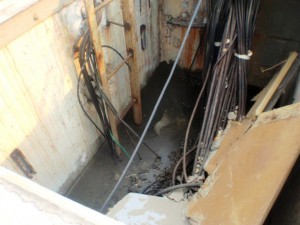
A conscious boycott of imported Japanese goods produced by large corporations would send a powerful message of protest. People have power. The economic power of the people can strongly influence the Japanese government.
In 2010, Japan exported to the world, goods with a total value of $765.2 billion U.S. Canada imports about $12 billion worth of goods from Japan every year. The United States imports over $148 billion worth. The biggest imports are motor vehicles and car parts followed by industrial machinery, computer and video equipment, electronic items, semi-conductors, construction machinery, motorcycles, rubber, iron, steel, aircraft parts, plastics, toys, games and sport equipment and foodstuffs such as seaweed, rice and green tea.
Consider the impact the threat of losing $765.2 billion dollars from the world could have in encouraging the Japanese government to take immediate action on moving those 1535 fuel rods to safe storage.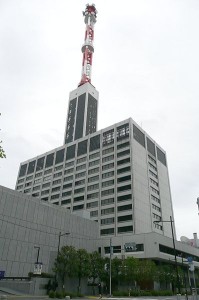
According to Jeff Jones, “boycotts are one of the very few powerful tools of the 99%. They should be used as often as possible. Industry and government HATE boycotts. Why? Because they work.”
Boycotting Japanese products would show solidarity with the people hurt worst by this disaster so far – the Japanese. The immense suffering caused by the triple meltdowns is staggering. The Japanese people have suffered before when atomic weapons were used against them at Hiroshima and Nagasaki. We’ve attended commemorations of these tragedies as Denise Anne and I are very close to the Japanese and Japanese-American community in Los Angeles even meeting and befriending a genuine hero who has fought for nuclear disarmament for decades based on his first hand experiences in Japan right after the war.
The Japanese people may not be entirely culpable for the nuclear power gamble its government has taken over the last half century. What happens now, however, is entirely up to them which will be daunting at best considering the cultural and economic challenges the Fukushima fiasco has and will cost. Once-rare anti-nuclear demonstrations against firing back up the country’s nuclear reactors have been impressive even if the vast majority of Japanese aren’t moved enough to register their discontent even as their country is being irradiated.
That wasn’t the case May 22 where protesters in Kitakyushu on the southwestern coast of Japan laid down in the road to stop a convoy of 22 trucks bringing rubble to incinerate from the tsunami-destroyed northeast of Japan where Fukushima is located. Within a week, a massive protest erupted against again in Kitakyushu to stop burning hot debris in its incinerator which was not built to be burning radioactive material.
The Japan nuclear industry/government is not only exporting their radioactivity all over Japan and to us in the form of cars, electronics, fish, seaweed and green tea, it is also exporting it in their radioactive air that comes our way. They are exporting it in the radioactive ocean water that they are dumping at the rate of 1000 tons per day. The Japanese government considers food that is 100 bq/kg as “safe to eat.” That level used to be considered “radioactive waste.” But the government took care of that by simply increasing the level that is considered safe. So that’s the level the Japanese government considers safe and that’s the level of radiation they export to the rest of Japan and to the world.
By spreading the tons and tons of radioactive debris around Japan and paying all the municipalities to incinerate it in garbage incinerators not equipped to filter out radioactivity, the Japanese government is committing a crime against humanity against its own people who, by and large, have acquiesced to getting nuked by their own government. By dumping 1000 tons of radioactive water into our ocean every day and insisting that 100bq/kg levels are safe to eat and thereby selling it to the Japanese people and the world.
On the Canadian and American side, the governments continue to import Japanese goods and our governments are not testing anything. So guess what – you can buy radioactive Japanese seaweed in America! This reporter proved it in April 2012. We tested Nori seaweed that I bought at a west Los Angeles store and found it to be 94.7% higher in radioactivity than the pre-Fukushima sample I also had tested.
It would be a powerful message if the Japanese people and all North Americans told the Japanese government that we are no longer willing to “import” their radioactive fallout. People don’t want to breathe it. People don’t want to eat it. People don’t want to swim in it. People don’t want it to fall down on us when it rains. People don’t want to “import” their Second Fukushima incinerated ash.
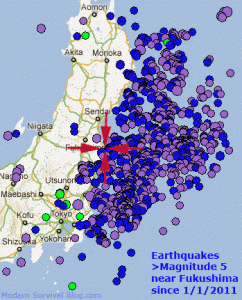 And we certainly don’t want to “import” the fallout from 3,488,000 tons of nuclear fuel that would destroy Japan and contaminate North America if Reactor 4 collapses.
And we certainly don’t want to “import” the fallout from 3,488,000 tons of nuclear fuel that would destroy Japan and contaminate North America if Reactor 4 collapses.
People have the power to say – enough – if you keep contaminating Japan and exporting your radioactivity, we will not export our money to you.
Once the Japanese government starts caring about the health of its own people and the health of everyone on the planet, we can start being concerned about their economy.
But then again, people do not want to cause even greater harm to the Japanese people who have already suffered so much that we can’t even imagine. The situation is too critical. The idea has to come directly from individuals and go directly to the government of Japan.
We, the people, could write directly to the Japanese government and promise that if it doesn’t take immediate action to remove the fuel rods from Unit 4, we promise to stop buying from the largest corporations in Japan. And there is only time to go to the person who has the ultimate power – Prime Minister Yoshihiko Noda.
German Chancellor Angela Merkel showed the world the power of a head of state. Before Fukushima, her government was planning to extend the life of their nuclear power plants by 12 years. After Merkel saw the catastrophe of Fukushima unfold, she took the oldest 8 reactors immediately offline and made plans to shut down 6 reactors by 2021 and the three newest reactors by 2022. The world can take an example from Germany.
Prime Minister Noda has the same type of power. He alone has the power to order an immediate escalation of the work to remove the fuel rods at Reactor 4.
A DIFFERENT KIND OF WAR
Fukushima is threatening all of Japan and the rest world with the ultimate nuclear contamination of the air, land, food and water. People could still promise Japan that they will not send their money to Japanese corporations if the problem of Unit 4 is not dealt with. In turn, the Japanese corporations must get together and insist that their government work to make reactor 4 safe so that the world will be secure and willing to trade with Japan.
So – is it time to boycott Japanese products from automobiles, sushi, entertainment, high-tech gadgets and any and everything that comes out of Japanese and Japanese-American stores selling products from the Land of the Rising Radiation?
Nearly 70 years after World War II, on March 11, 2011, it seems a new kind of war has been declared on the northern half of the planet with the enemy being nuclear reactors and the hubris of the governments that allowed them in the first place: Japan and the United States.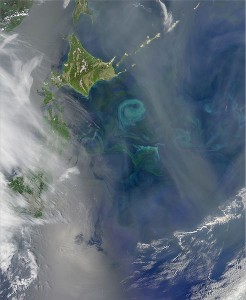
This war was heralded by six minutes of hellish shaking, the seemingly endless march of merciless waves from the tsunami and the meltdowns of three old reactors built foolishly next to the ocean which then exploded when shaken and smashed apart by by what Japanese nuclear engineers ignored.
But unlike World War II, the belligerents of this world war, the Japanese, American and Canadian governments, among others, are cowards and fools obscenely and blithely blowing off the blatant injury to the planet and its inhabitants caused by this unprecedented series of nuclear disasters at Fukushima-Daiichi.
Aided in this crime against humanity and the environment by much of mainstream media, North Americans, including our friends in Mexico, are left with no warning, no defenses, and no guidance.
We are on our own. But we are not helpless. We can face the perpetrators, foreign and domestic, and tell them that we will not stand for this destruction of the environment and possibly humanity. Common sense, sound science and the will to live free leaving a better planet for future generations cannot be trumped by the forces of greed, repression, ignorance and fear.
Those who fought in World War II are oft referred to as “the greatest generation.” If we do nothing to stop this imminent nuclear catastrophe, we can damn well bet our moniker will be “the most hated generation.” And rightfully so.
But it is not too late to act. A new nuclear-free renaissance is possible through determination and fortitude that can help humanity find its way towards a future free from the unforgivable fire.












After reading most of the news here especially the unforgettable fire, I have come to an absolute final conclusion to save Japan and the rest of us the planet world, just as a lay person who wants life not death , is to have Japan declare Fukushima a national sacrifice zone after evacuating all population. Once the whole plant sinks under the ground or partly in the ocean which is already contaminated anyway beyond repair, then start pouring from the air tons and tons of Boron and cement etc. day and night until the crater is completely filled. Just maybe we can save our breathing air this way and people simply don’t eat any more seafood. Any better solution and I urgently want to know! Thanks.
As a species, we seem to be the only one foolish enough to invent things beyond our abilities to control them….This disaster, and the subsequent denial of the truth by all media is amazing. If this isn’t fixed, a good part of the planet will be uninhabitable. Our food chain has already been destroyed by the radiation of fish, soil, crops and air.
I am a historian, and have often wondered if illness, disease, war, plague, etc. is what destroyed the ancient civilizations causing them to vanish overnight. Perhaps it is this same insane denial of the truth (whatever it might have been) that caused it.
We seem to be able to progress only so far before our progress destroys us. I think our demise started with the splitting of the atom. It was a technology that should never have been revealed. If we could have stopped somewhere before WW I in development, we might have been able to go on for centuries. From 1800-1920 We went from candlelight to electric lighting, horse and buggy to autos and aeroplanes. We developed the telephone, telegraph, railroad….so many things that will be remembered as as golden era. Now, we face disaster, and our leaders deny it as if by pretending it doesn’t exist, it won’t hurt us.
We may well be experiencing our own extinction.
Thanks for a great article not seen elsewhere.
Sincerely,
Marilyn Gjerdrum
@nateobie: We included your nitwiticism as another glaring example of the anonymous ‘experts’ that like to goo up the works by insulting folks here. We don’t explain how “fission works” rather use the word twice in this long piece to refer to the unfortunate process of uncontrolled radioactive goo going critical once again achieving fission outside the (semi) controlled space of an intact and functioning reactor. Professor nateobie here ought to stick to looking at the neat photos.
@nateoble – Could you please educate all of us “uneducated” on how fission really works? If you know something we don’t it would be great to know. I, for one, would love to know that we really don’t have a problem here. Then I could go back to my old easy life and stop worrying.
p.s. great pics tho.
Wow…This author is seriously uneducated on how fission actually works. Go back to school buddy. Stop freaking people out because you are ignorant. All you readers, try getting a second opinion before you believe any one man’s claims. Wow…you must be one of those believers in dihydrogen monoxide.
We will all be dead men walking if reactor #4 becomes the cause of a world-wide nuclear catastrophe. And, if it were not for your amazing articles, Michael, it really would be almost a totally dead silence….with emphasis on “dead”.
Why are not ALL of the major newspapers putting articles like this on their front page, and in the headlines? This is surely denial on steroids!
I thank you again and again, Michael, for your knowledge, your writing and for having the strength and bravery to keep at it, no matter what. If any lives get saved here, it will be thanks to you!
IRRESPONSIBLE, TREASON TO HUMANITY, INCOMPETENCY,TOTAL NEGLECT. THE WORLD IS IN DIRE STRAIT.EVEN YOU THAT PUT THE HEALTH OFF THE PEOPLE OF JAPAN CANNOT ESCAPE THIS DISASTER THAT IS ABOUT TO HAPPEN. GET WITH IT PICK IT UP GOVERNMENTS OF THE WORLD BEFORE ITS TO LATE.
cant they just nuke the thang?
Exactly! Excellent article.
“We are on our own. But we are not helpless…”
– Michael Collins
“I want to live free, free of contaminated air, water and food.” – Chase
Why and how, did this basic right of existence get corrupted, stolen and forever changed and possibly destroyed?
Does it matter now?
Do the masses really care?
Do most people really understand?
I cannot answer these questions directly, because none of this makes any real sense to me. Corporations and militaristic governments playing God I guess.
from a comment elsewhere:
“The reactor that is my soul has reached criticality.”
– user johnnyo enenews
“Judging by the pollution content of the atmosphere, I believe we have arrived at the late twentieth century.”
–Spock in ‘The Voyage Home’
Sub in ‘radioisotope pollution’ for ‘pollution’ and ‘early twenty-first century’ for ‘late twentieth century’, and I think he’ll have it about right.
Those with huge IQ’s in the industry, or remotely tied with the industry knows these things, yet nothing is done to prevent this outcome? Have we overstepped technology? The powers of magical thinking have brought us to this point. It says a lot about how our psyche’s choose to perceive ultimate destruction. If we could only step out collectively of our current illusion and be adult enough to face and tend to reality. Has television corrupted our minds to this extent? Or is it the brains attempt to calm our unsteady nerves?
The 60 ton lid placed on #4 SRP is protecting it from the structure to be built that will facilitate the eventual removal of the rods for dry cask storage. This cover will ensure any construction debris that could fall, will not hurt the remaining condition of the rods.
Funny how unit 4 exploded when it was out of service for refueling – you even have a picture of its containment lid sittting in its holder. So do tell how did the reactor explode? Also how come no mention of reactor 3 the real story it did explode and it was full of plutonium mox fuel? You know the most toxic substance known to man.
The world leaders are sociopaths! They always end up in control inevitably causing death, misery and suffering. We sheeple just follow along like the blind fools that we all really are.
Greed and stupidity do not make answers for why we are being continually poisoned and tortured in just so many ways. Look all around you and ask why are we continually be subjected to out and out negative scenarios in every way shape and form as we go along here?
The time is now to wake up people! Wake up from the dream they are creating for you, or shall i say nightmare! This is our only chance to change what awaits or future. I will assure you that it will not be pleasant unless we wake up now!!
The people of Japan are “Dead Men Walking” thanks to TEPCO and Government politics….Lies Lies Lies… and soon they might take down the whole world.
Here’s my article that analyzes the likelihood of another big quake, the topic of the last section of your dynamite article:
Humanity at the Height of Folly
Nuclear Power and Earthquake Zones
http://dissidentvoice.org/2012/05/humanity-at-the-height-of-folly/
Michael, Great article. I had not kept up on the lid issue. That is very freaking weird to be sure. Arnie Gunderson keeps telling them to get the fuel rods out of there as soon as possible, but since their logic is so opaque at best we cannot know what Tepco thinks and at worst your speculation may be correct: THESE PEOPLE ARE COMPLETELY BONKERS.
I live in Japan and have written a number of articles about this (see below). Most people here are in complete ingnorance/denial of the seriousness of it all. A professor I know even said an article by Mr. Muramatsu, the diplomat who has done so much to expose the Unit 4 crisis, as “tabloid journalism”! And I am afraid this is typical of the silly pride/stupidity of people in general. Thanks for your great work Michael, we love you, Concrete man
Tokyo Electric Power
Company’s Radioactive Lies
The Arsonist Investigating The Fire
http://www.rense.com/general95/tokyoars.html
6~20~5993
We are fighting the radiation by taking Iodine drops in water, Boron, Green Tea Extract, VitC, D3, Magnesium, and other liquids, capsules. Replaced cows milk with Almond milk because Almonds help kill cancer. Please keep informed!
We are also sealed in the Names of the Father and Son (Yahweh and Yahshua), Revelation 14:1. Now we know WHY!
Yahshua returns SOON!
Please, people, make a positive difference in this worst tragedy ever…
Where is Superman when you really need him ????
Me thinks the nationwide burning of rad debris is to purposely raise the overall background in the country, the same old modus operandi of the Department of Energy and Nuclear Regulatory Commission witnessed here stateside. After all, this Fukushima is an American-esque Chernobyl: created, engineered, and continually educated by American professors — whether we yanks like it or not. Higher background measurements equals less money spent on cleaning up radionuclide contamination as we have learned from your marvelous coverage of the Rocketdyne mess. Higher background also lulls one into a sense of complacency in mistakingly believing food tested on an Inspector device near background is safe to consume; the news is in, IT IS MOST DEFINITELY N-O-T!
‘GENERAL ELECTRIC’ does not have any Japanese in the name. What is going on in Japan today was gleaned from their allies, the Americans — plain and simple. Investigate the authoring of the Japanese Constitution, see for yourself just how postwar Japan came to be…
Next they will declare National Sacrifice Zones in Japan, just like guess where? The good ol’ USA. Gee, thanks so much DOE!
If you are a responsible male, I implore you: get a genetic test before going about creating any new life (ie., baby making). Cesium-137 concentrates in the testes. FYI, UCLA has the capability to run this test. Write Planned Parenthood and teach them the problem please, then maybe free testing for couples will become the norm.
http://www.massey.ac.nz/massey/about-massey/news/article.cfm?mnarticle_uuid=7B5D3A49-96BF-57FE-A849-E369E6196A27
Boycotting General Electric though? Yes, by all means. Let’s start today. Ostracizing Jeffrey Immelt? The President already has, FWIW. Nailing idiots who pursue nuclear anything? As long as we start with the fat cats with deep pockets first (USA, France, Russia, China, UK, Israel, India, Pakistan, Koreas, and et al.)